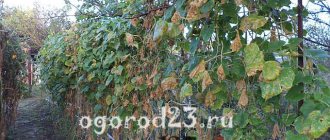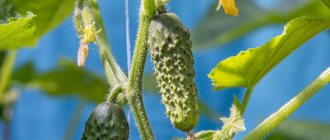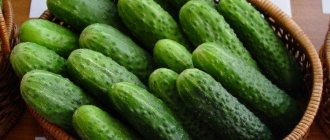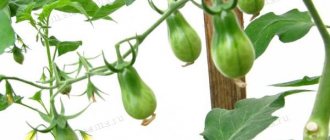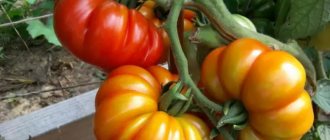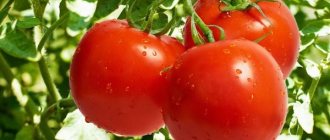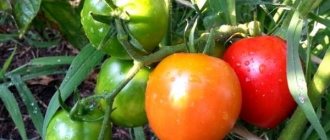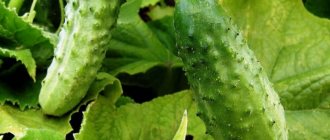Author's rating
Author of the article
Yakov Pavlovich
Professor, Head of the Department of Vegetable Growing
Articles written
153
Bunch cucumbers are a modern high-yielding hybrid of a popular vegetable, real record holders for yield. Having long and abundant fruiting, most varieties of bunched cucumbers do not require the presence of bees. Growing this type of crop is a rational choice for vegetable growers: with proper care, including watering, fertilizing, and shaping bushes, a bountiful harvest will surprise and delight you.
Bundle cucumbers - plant features
Bundle varieties are called bouquet varieties due to the appearance of the ovaries: one node “produces” several flowers at once. Accordingly, the greens on the vine are not arranged in 1-2 inflorescences, as in ordinary varieties, but in bunches of several pieces. Varieties that produce more than 8 ovaries in a bunch are called super-tufted. Harvesting from one lash of bunch hybrids reaches 10 kg - they have no equal in terms of yield.
Bouquets of ovaries are located unevenly on the lashes: at the top and in the middle of the lash, there are more ovaries in one bosom than at the bottom. Flowers in bunches do not always bloom at the same time, so one bouquet can bloom for 1-3 days. The entire number of ovaries in a bunch does not mature, however, as soon as one dies, it is immediately replaced by another embryo.
The hybrid represents the first generation obtained from crossing varieties with predominantly female ovaries, therefore the F1 mark is present after the names.
conclusions
It is quite easy to get a good harvest of magnificent cucumbers by choosing bunch varieties, which, with minimal care, will bear fruit well until late autumn. Moreover, it doesn’t matter what size your garden plot is, you will always have cucumbers, having planted these high-yielding hybrids, so beloved by many vegetable growers precisely because not just one ovary is formed on one node, but a whole bouquet of delicious juicy fruits. You just have to put in a little effort, and the harvest will certainly please you.
Read about the most productive cucumber seeds of Siberian selection here.
Advantages and disadvantages
It’s not for nothing that bunch hybrids are gaining increasing popularity - they have many advantages over conventional varieties:
- consistently high productivity. It is ensured by the fact that there are many flowers in the inflorescence and they bloom gradually;
- mass ripening - 12-15 cucumbers are filled with juice at one time;
- small-sized fruits - high competition for food does not allow greens from one bouquet to outgrow;
- long fruiting period;
- saving space in garden beds. One bush of a bunch hybrid replaces several ordinary ones;
- high taste qualities. The lack of bitterness in them is genetic, they are crispy and sweet;
- have high immunity to most “cucumber” diseases, plus, due to early ripening (45-50 days in most varieties), they do not suffer from harmful insects, the peak of invasions of which occur at a later time;
- resistance to temperature changes;
- a large number of varieties, allowing you to choose the most suitable one.
These cucumbers have much fewer disadvantages:
- they cannot be propagated. The vast majority of varieties do not have seeds at all, since they do not require pollination. But even the seeds do not retain varietal parental qualities. You need to purchase them again every year;
- the cost of seeds is significantly higher than ordinary cucumber varieties, but it certainly pays off with a much higher yield.
Dividing cucumbers into 4 classes
- Active branching type. Side shoots are formed literally in the axil of each leaf, so cucumbers need careful shaping and constant pinching. These varieties are resistant to high temperatures. Particularly notable are Dragonfly, Matryoshka, Focus and Petrel.
- Moderate or limited type of branching. They are distinguished by a large number of short side shoots. Cucumbers do not require special growing conditions; the bushes are easy to form and bear fruit for a long time. In this class, the hybrids Ant, First Class and Grasshopper are in demand.
- Cucumbers with weak branching. This includes hybrids of super bunched, early ripening varieties. The main and largest harvest is formed by the first ovary, then fruiting proceeds in decreasing order. Artel, Bouquet and Alphabet are popular here.
- Balcony hybrids of the gherkin type. Super bunched cucumbers, designed for growing indoors with limited lighting. They are distinguished by a large number of ovaries in the node. The fruits have high taste, but are consumed only fresh. The varieties F1 Balcony, F1 City Cucumber and F1 Hummingbird are more suitable for balconies.
In the video, the agricultural technician talks in detail about bunch varieties of cucumbers, how to grow them in a greenhouse, how to plant them, how to form a bush, and also recommends the best brands of complex fertilizers:
Popular varieties
There are several varieties of bunch cucumbers:
- actively branching, when almost all nodes located on the main stem are released along the side shoot;
- moderately branching, producing many shoots of short length with shortened internodes;
- weakly branching - as a rule, ultra-early ripening hybrids;
- balcony - with a vigorous main stem, but small fruits and leaves.
This classification helps to choose varieties that are most suitable for different conditions - greenhouses, open beds, the need for shaping or the ability to do without it.
Tufted Robin Hood
Parthenocarpic hybrid with early ripening. The yield is average, the harvest is about 6.5 kg per square meter of planting. Plants are weakly branched and medium tall. There are mainly 5 fruits in the nodes. Gherkins grow up to 6 cm in size, have light stripes up to a third of the surface of the green background and black, large-tubercular spines. There is no bitterness in the taste. Equally good for salads and pickling.
Suitable for cultivation in both the north and south of the country. The seedling method is preferable in places with a cool climate; in warm climates, you can immediately plant seeds. Cucumbers are very unpretentious and get sick extremely rarely.
King of the bed
One of the few bunched cucumber hybrids that require pollination. Early ripening, with fruits 9-10 cm in length. Has up to 3 ovaries in the axils. Cucumbers with light stripes, large tubercles.
Designed for growing in open beds with preliminary cultivation of seedlings. The hybrid is not susceptible to powdery mildew and withstands difficult weather conditions well.
Hybrid Detinets
A mid-early variety, characterized by medium branching. The number of fruits formed in one axil is 5-7 pieces. They grow up to 12 cm in length, light green with yellowish stripes, medium tuberculate with brown pubescence. There is no bitterness in the taste.
The productivity of Detinets is up to 14 kg/m2. Equally good fresh or prepared.
Beam splendor F1
For the regions of the Urals and Siberia, this bunch hybrid is one of the best self-pollinating ones. It is advisable to germinate the seeds. Then the crop is cultivated outdoors or in greenhouses. Like most hybrid bunch varieties, it has a predominantly female type of flowering. 7-8 cucumbers are formed in the sinuses. Zelentsy grow up to 11 cm in length, have narrowed tops, light green color with even lighter stripes, and are covered with white spines.
The variety does not suffer from brown spot, cucumber mosaic, or powdery mildew.
Snowstorm
An ultra-early ripening bunched parthenocarpic variety allows you to harvest gherkins already 37-39 days after the seedlings peck. The bushes are medium-sized with weak lateral branching (especially in the lower tiers), the flowers on them are only of the female type. It is necessary to plant a small number of pollinator plants.
See also: How to properly form cucumbers in open ground and greenhouses
In bouquets, 4-5 fruits are formed, which grow up to 6-8 cm long. The color is dark green with contrasting light stripes, and the shape is oval-cylindrical, with brown pubescence on the tubercles.
In areas with cold climates, seedlings must be grown first. The variety does not suffer from downy or powdery mildew. Universal use.
Master
An early ripening gherkin bunch hybrid that does not require pollination and produces long-term fruiting. Grows wonderfully in open ground or outdoors. Has weakened branching - forms numerous lateral shoots of short length. Forms bouquets of 2-6 ovaries. Zelentsy grow no more than 12 cm long. They are tuberculate and white-spined.
Acorn
The bunch variety received its name for its small crisp green gherkins of a bouquet type. High-quality fruits measuring a maximum of 8-11 cm have universal use - either fresh or for pickling. The super-bundle hybrid (the number of ovaries formed at the nodes is from 2 to 12) has a purely female type of flowering, and therefore requires pollination (10% of pollinating plants are sown with it).
Suitable for greenhouses, open beds. It does not suffer from mosaic viruses or olive blight, and is tolerant to downy mildew and common powdery mildew.
Description of the variety “Beam splendor F1”
Cucumbers “Beam Splendor F1” are a parthenocarpic hybrid that does not require pollination to begin the growth of numerous ovaries. The cost of 5 seeds is 85 - 105 rubles (depending on the manufacturer). Two productive hybrids took part in the selection. Judging by the description of the “Beam Splendor” cucumbers provided by the manufacturer, you can count on a yield of up to 50 kg per m2.
In the female internode, 5-7 ovaries are formed simultaneously. Minimum quantity – 3 pieces. The cucumber variety “Beam Splendor” has no male internodes and weakly branches. Therefore, it does not need pinching and pruning in order to form an unthickened vine. Zoned for risky farming zones in the Urals and most of Siberia. Suitable for growing in film and polycarbonate greenhouses, greenhouses and tunnels. In open ground conditions it often reduces yield by up to 20 kg per m2.
In the description of the “Beam Splendor” cucumber variety, the manufacturer indicates the need for almost daily abundant watering with warm water. Large amounts of organic and mineral fertilizers are also required weekly. Without fertilizing, this variety will not give the expected yield and will completely disappoint the gardener. When loosening, do not go deeper than 5 cm. The root system is located very close to the surface of the soil.
Jacobinia - growing and care at home, photos of species
General information about this variety of bunch cucumbers:
- fruit type – gherkin;
- the minimum length of greens is 5 cm, the maximum is 11 cm;
- The shape of the cucumber is cylindrical, without ribs, smooth;
- spines sparse, white;
- the color of the fruit is light green with faint white stripes;
- taste qualities are excellent;
- Suitable for salads, canning by salting and pickling.
In a greenhouse, it can yield crops due to the growth of new shoots before frost. Resistant to powdery rose, fusarium, brown spot, gray rot. Tolerates temporary drops in ambient temperature to +5°.
The cucumber “Puchkovoe splendor F1” in the photo is not much different from gherkins of other varieties, but its taste is excellent.
Features of growing bunch-type fruiting cucumbers
Due to their multiplicity, bunched cucumber plants cannot “nourish” all the ovaries that form. The percentage of complete formation, and therefore yield, largely depends on the level of agricultural technology. To grow a good harvest, it is necessary to feed the bushes correctly and often enough, as well as to correctly shape them, taking into account the type of branching. In general, the principles of caring for bunch hybrids do not differ from the rules for caring for ordinary cucumbers.
Lighting
All bunch varieties are photophilous. Some of them are adapted to grow in partial shade, but in general, the higher the degree of illumination, the more ovaries are formed in the axils. Therefore, the best place for bunch hybrids is sunny areas protected from drafts.
The soil
The soil requirements do not differ from those common to any variety of cucumber crop: well-drained, providing air access to the root system of the plants, loose and nutritious. Any cultivated soil with a high organic content is good.
If the soil is heavy, waterlogged and cold. ridges 30–40 or more centimeters high are poured with a “warm” layer of organic ingredients.
Wind protection
In open ground, cucumbers need protection from wind, especially cold wind. If the area is windy, next to the cucumber beds, tall-stemmed plants are sown in advance, even before planting the main crop, to create a protective curtain - corn, sunflowers or tall varieties of legumes.
Cucumber varieties resistant to downy mildew. Varieties and hybrids of cucumbers resistant to downy mildew
Downy mildew (downy mildew) is a disease that is currently widespread. All varieties and hybrids of open and closed ground suffer from its harmfulness and often completely die.
Conditions for the development of peronosporosis
- The fungus attacks the leaves of plants of any age.
- For its development, high air humidity, the presence of drip moisture on the leaves and an air temperature of 16-18°C are necessary.
- First, single brown-yellow spots of angular shape appear on the leaves, which, under favorable conditions, quickly increase in size, covering the entire leaf blade.
- Affected leaves turn brown, dry out and fall off.
Systemic fungicides somewhat inhibit the development of diseases. But their use is undesirable due to the long waiting period (20 days). The fruits should not be eaten at this time. _____________________________________________________________________
TREATMENT OF CUCUMBERS FOR PERONOSPOROSIS _____________________________________________________________________
Cucumber varieties resistant to downy mildew
In this situation, the solution can be considered to be the cultivation of early-ripening, ripening varieties and hybrids, the harvest of which arrives before the spread of the disease.
- The resistance of a number of varieties is due to the fact that they very quickly grow new leaves instead of dead ones.
- The speed of growth of the leafy stem mass largely depends on regular fertilizing.
- The correct choice of cucumber variety or hybrid for growing is very important.
The choice of resistant varieties is large:
- coarsely tuberous,
- suitable for pickling,
- with fine pubescence,
- for canning,
- smooth-fruited.
Every gardener can choose for himself what he likes. __________________________________________________________________
25 BEST CUCUMBER VARIETIES FOR THE GREENHOUSE ___________________________________________________________________
Resistant cucumber hybrids
Of the cucumbers I grow, I would like to note the parthenocarpic hybrids:
- F1 Adam,
- F1 Bettina,
- F1 Temp,
- F1 Claudine,
- F1 Karin,
- F1 Angelina,
- F1 Harmony,
- F1 Pro,
- F1 Paratunka,
- F1 Courage,
- F1 Herman
___________________________________________________________________
GROWING CUCUMBERS IN A GREENHOUSE
Photo: cucumber F1 Mondial
- For cucumbers, the air humidity in the greenhouse should be about 80%.
- At low humidity, the taste of the fruit decreases somewhat (the peel becomes tougher).
- In these conditions, smooth-fruited F 1 Mondial and F 1 Katya are irreplaceable, maintaining a balanced taste.
Photo: cucumber F1 Katya I consider the record holder F 1 Ecole to be the best in this group.
- All recommendations advise: you should not plant cucumbers and tomatoes together. My experience gives a clear answer - you can!
- 4 cucumbers per season yielded a harvest of 40 kg. At the same time, they all successfully escaped from peronosporosis.
- And F1 Ecole brought 11.7 kg and 123 (!) fruits from one plant. And all this side by side with tomatoes.
Photo: cucumber F1 Ecole Of the salad varieties, F 1 Ceres and Chinese varieties have good taste. And at the same time very highly productive.
- I also liked the American variety Juan Dickfleich with greens in 800 g.
- The Korean Chun Kyu Wong is not far behind with long fruits up to 70 cm.
Photo: cucumber F1 Ceres Our white-fruited F1 White Angel amazes with its amazing beauty.
Photo: cucumber F1 White angel
- The furry Italian Barrese is charming.
- But the Armenian cucumber will baffle anyone: with its appearance (isn’t it a zucchini?), its leaf structure (exactly like a melon), and its size (about a meter long and 2.5 kg in weight).
Timing and technology of planting cucumbers
Agricultural technology for growing bunched cucumbers, as well as regular ones, involves the use of seedling and non-seedling methods. The regions of the country differ greatly in climate; the timing of planting crops differs for them by several weeks - you need to focus on local weather conditions. The crop is hypersensitive to cold: good seed germination is possible only at air temperatures above 12-14°C. The soil should warm up by 10°C at a depth of 10 cm. Therefore, in the north of the country it is recommended to grow early varieties, such as bunched ones, through seedlings. This speeds up the production of the first fruits by about two weeks.
Hybrid seeds do not require pre-sowing treatment. For seedlings, they are sown in small containers about 10 cm high. The nutrient mixture is prepared from one part of small sawdust and 2 parts of humus and peat. For 10 liters of this mixture add 2 tbsp. spoons of wood ash and 1.5 tbsp. spoons of nitrophoska. In the phase of 2 true leaves, seedlings are fed with nitroammophos or nitrophoska (3 teaspoons per 3 liters of warm water).
It is better not to disturb the root system of bunched cucumbers, like ordinary cucumbers, so picking the seedlings is not necessary. It can be transplanted to permanent beds after a month.
In greenhouses and greenhouses
In protected ground, it is better to grow self-pollinating varieties of bunched cucumbers, so as not to depend on the rare arrival of pollinating insects into greenhouses.
Planting bunched hybrids in greenhouses can also be done using seedlings and without seedlings:
- with direct sowing under cover, mass shoots can appear after 4-5 days. It is important to provide them with access to fresh air to prevent overheating and death;
- The seedlings are transferred to the greenhouse in the phase of 3-4 true leaves. Before sowing, fertilize the soil with conventional complex mineral fertilizers. Water every other day or as the soil dries out.
Gartering and shaping should begin a few days after planting the seedlings.
In the open ground
A week before planting, the finished bed is fertilized with compost with the addition of complex mineral fertilizer. Since bundle hybrids do not like crowding, they are planted at a distance of at least 40-50 cm, and highly branched varieties are even less common. They install a trellis (its use allows you to increase the yield of bunched cucumbers several times) and also begin to form bushes in a timely manner in order to achieve maximum yield.
Planting seeds is similar to planting in greenhouses, but you will have to wait a little longer for germination. Seeds are planted in the beds in one or two rows.
Differences and advantages of bunched cucumbers for open ground
Not so long ago, gardeners preferred to grow hybrid varieties of cucumbers F1 Zozulya, F1 Legend or F1 April in greenhouses. Twenty years ago, short-fruited varieties were more often planted in open ground, such as Altaisky Ranniy 166, Dolzhik, F1 Rodnichok and Shchedryy 118. They gave a very good harvest, and are still in demand in specialized stores.
Tips for the garden, vegetable garden and flower garden
Carnation Shabo planting seeds for seedlings
When is the waning moon in March 2021 in Russia
When to ferment cabbage in March 2021 according to the lunar calendar
The advantageous difference between hybrid annual bunched cucumbers is that up to 9 ovaries can form simultaneously in one node on a bush - a whole bouquet. Therefore, unique collectible hybrid cucumbers with incredible yields are even called super-bunch cucumbers. They definitely deserve this name.
The number of greens on each bush is comparable to the yield of ten plants of a regular variety. Bundle cucumbers effectively save not only space, but also energy for summer residents.
Main advantages:
- All bunch varieties are maximally resistant to the main diseases affecting the pumpkin family. Summer residents know how afraid cucumbers are and how susceptible cucumbers are to various diseases. For example, powdery mildew can destroy a garden bed in a few days.
- Varietal cucumbers often suffer from changes in air temperature. These atmospheric influences do not affect bunched cucumbers in any way.
- Early ripening: bunch varieties begin to bear the first fruits forty days after planting.
- Excellent taste of fruits. Tender bunched cucumbers are ideal for pickling, pickling and salads, as they never suffer from bitterness.
- The productivity is so high that optimal care conditions make it possible to harvest up to ten kilograms of high-quality cucumbers from each bush.
- A large selection of varieties allows you to choose the most suitable one for yourself.
Among the disadvantages of the variety is the need to frequently collect greens in order to prevent overgrowth and the possibility of full ripening of new ovaries. This is a very relative minus in comparison with the incredible advantages of bunch varieties.
Necessary care
Despite the fact that bunching is a genetic factor, the number of ovaries depends largely on cultivation conditions and plant health. Excess nitrogen in the soil, lack of watering, severe overheating, and too rapid growth of the main stem reduce the number of green plants formed.
Feeding
Bunch cucumbers need feeding more often than regular varieties. Complex mineral fertilizer is added during watering weekly in small doses - 10–20 g per square meter of plantings. When the number of ovaries decreases, feeding is reduced.
See also Growing the Phoenix cucumber variety
Watering
Water bunched cucumbers once every two days or daily if it’s hot. Focus on the top layer of soil; it should remain moist, but not overly flooded with water. On waterlogged soils, cucumbers grow green foliage to the detriment of flowering.
It is better to water in the evenings, when the sun has set, or in the early hours, so as not to burn the leaves through the “lenses” of the drops remaining on them. The water should not be cold.
Shaping and garter
Plants of bunch varieties begin to form a week after planting cucumber seedlings, when 8-9 leaf blades appear. In bunched hybrids, lateral shoots appear in the leaf axils along the entire length of the main stem. If left, thickening will negatively affect the number of ovaries per node, as well as the growth of fruits on the main stem. Therefore, they are usually formed into one stem. This increases productivity, saves labor costs, and improves the taste of the fruit.
Working technology:
- the lower 4-6 nodes blind in advance, even before the start of flowering, pluck out the buds of lateral shoots and female ovaries from the leaf axils. This will allow the plants to grow faster and develop powerful leaves. Those seedlings that were lagging behind in development will take root well;
- Along the main stem, the lateral shoots are then removed until the beginning of the trellis wire. They do this while they are small (they have not outgrown 3-5 cm). Leave 2-3 shoots on the main stem under the trellis, before pinching them into 2 leaves;
- when the top of the shoot grows to the top of the trellis, it is wrapped around the wire a couple of times;
- if it reaches a neighboring plant, it needs to be pinched.
In this way, nutrients are redistributed in a bunched plant and the filling of greens on the main stem is stimulated (it should be taken into account that the share of the harvest from it in bunched hybrids is usually no less than 60%). Removing side shoots at the bottom and middle part of the main vine promotes good aeration and illumination of the lower leaf blades.
If you carry out the formation of bunch varieties in the manner described above, fruiting will occur a couple of days later, but within a week the yield will be 2-3 times higher than without it.
Prevention from insects and diseases
Fortunately, most varieties of bunch hybrids have stable immunity to the main diseases of the crop, and their early ripening period guarantees that harmful insects, the main period of development of which occurs at a later date, will not cause them damage. However, to further reduce the risk of disease, it is worth taking appropriate preventive measures:
- observe crop rotation (when the same crop is cultivated annually, certain types of pests and pathogens accumulate in the soil);
- carefully remove weeds not only inside greenhouses, but also around them, since many pests find refuge there;
- remove old, dried fruits and flowers from the ovaries;
- maintain the healthy state of plants by timely watering and fertilizing;
- regularly inspect them, especially along windows and paths, for timely identification of pests.
It is very important to maintain temperature and humidity conditions if bunch varieties are grown in a greenhouse. Despite the fact that they love warmth and moist soil, overheating reduces the number of ovaries formed, and constant dampness is fraught with the development of putrefactive processes on the roots.
How to harvest correctly
Fruits from bunched hybrids are collected frequently - daily or every other day. Overgrown specimens inhibit the growth of new ones. If visiting the estate is possible only once every few days, then choose gherkin-type varieties. A large number of ovaries on them inhibits the growth and outgrowth of green plants.
The best time to collect fruits is early morning or late evening. At this time they are more elastic due to the abundance of moisture. Usually, cucumbers are plucked off with your fingers, although it is more correct to use pruners or a knife for this, leaving the stalks on the vines. When collecting, do not pull the vines or tug them, so as not to damage the root system, and also try not to turn the leaves over - cucumber bushes do not like this.
